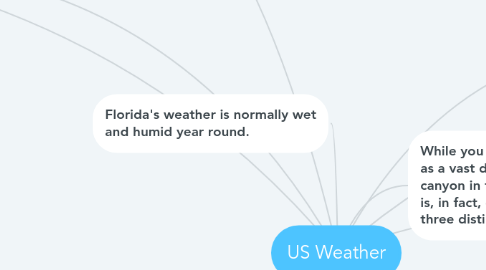US Weather
by Chazlina Archer

1. Florida's weather is normally wet and humid year round.
2. The climate of the north and central parts of the US state of Florida is humid subtropical. South Florida has a tropical climate.
3. The winter months (from early November to late May) are much drier and cooler, and in the north frost is possible during the mid-winter months of January and February
4. Tropical storm activity reaches its peak during August along the coast of Florida, so it is wise to keep watch on the weather forecast. High temperatures, frequent thunderstorms and soaring humidity levels combine to make conditions uncomfortable
5. California has more of a Mediterranean climate. With hot and dry summers and mild rainy winters.
6. Northern California has fog in the spring, snow in the Winter, and is dry is the summer.
7. Earthquakes are a regular occurrence throughout the state, especially near San Francisco.
8. The influence of the ocean generally moderates temperature extremes, creating warmer winters and substantially cooler summers in coastal areas.
9. While you may imagine Arizona as a vast desert with a giant canyon in the middle. Its climate is, in fact, quite diverse, with three distinct regions.
10. Virginia is a four-season state. August days can be - on the average - hot and humid, while January days can be cold and dry
11. On average, it rains or snows in Virginia for roughly 110 days each year.
12. Key factors that shape Virginia's climate, aside from global weather patterns and latitude, include:
13. the Atlantic Ocean/Gulf Stream
14. the Appalachian and Blue Ridge mountains
15. the state's complex pattern of rivers and streams
16. The Sonoran Desert, which covers most of the southwestern portion of the state, is one of the hottest and driest places in North America.
17. he Central Highlands region sees annual rainfall averages of 15 inches, with 52 percent occurring in July and August. In the higher elevations of the White Mountains, winter precipitation comes in the form of snow.
18. The elevation fluctuations in the Colorado Plateau showcase how much influence altitude has on the weather. Annual rainfall in the region is around 10 inches, with much of it falling as snow in the San Francisco Peaks outside of Flagstaff and Mt. Baldy in the White Mountains.


